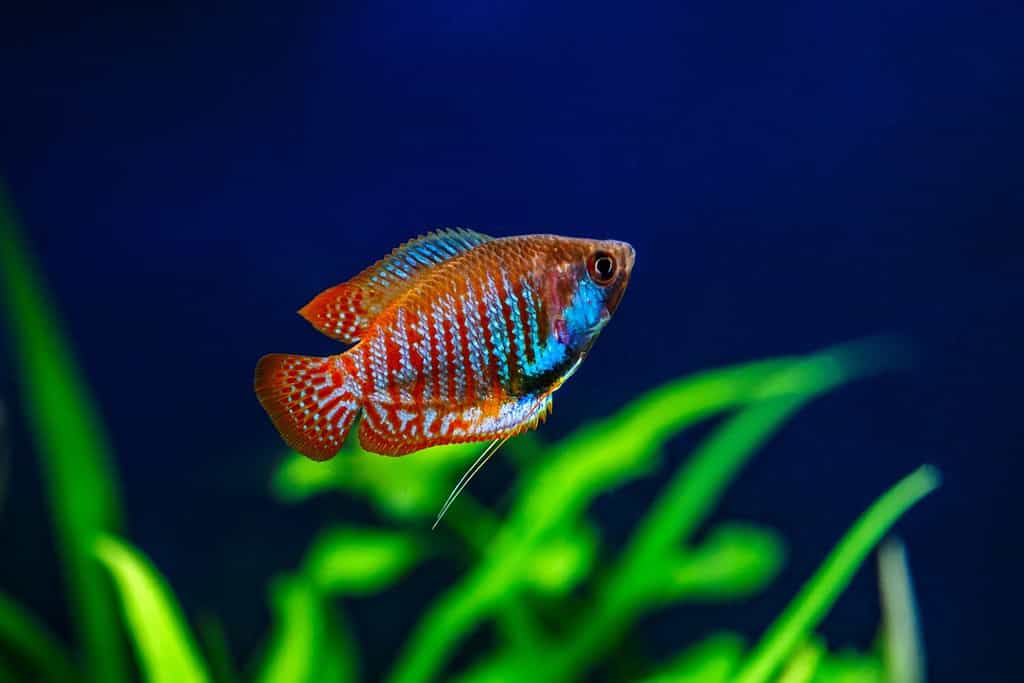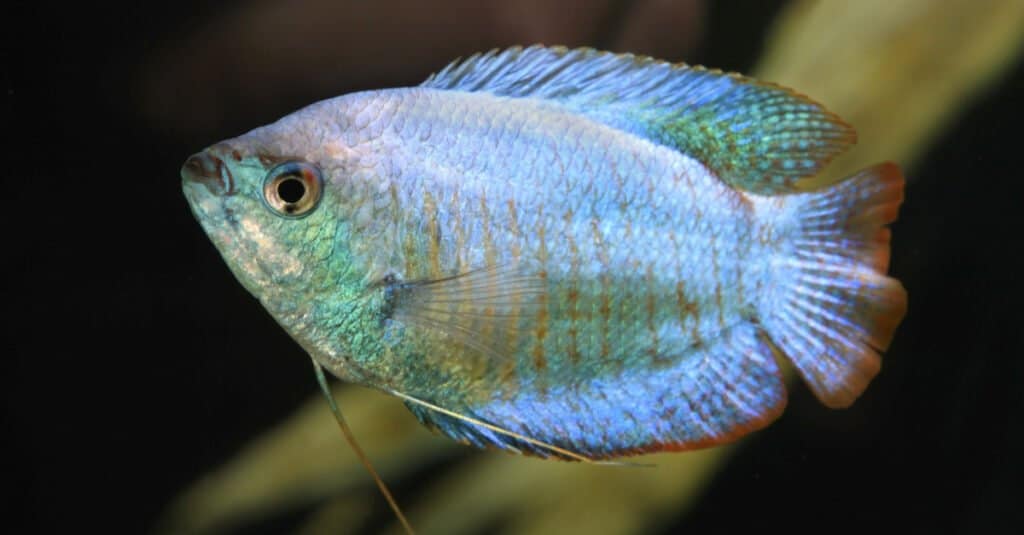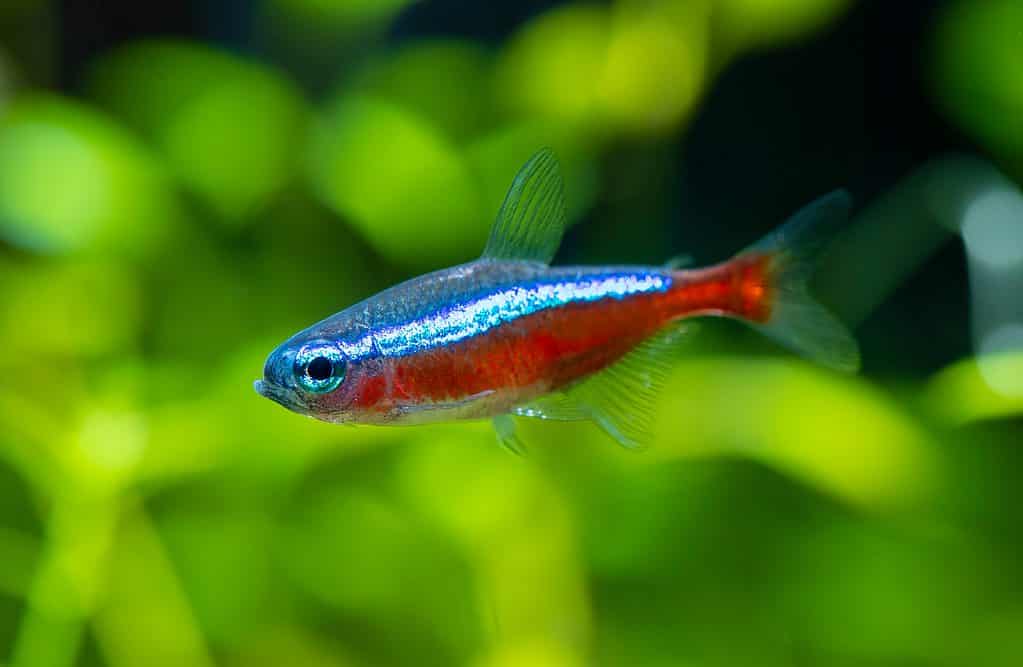Dwarf gouramis are a popular choice for aquarium enthusiasts due to their vibrant colors and peaceful temperament. These small, brightly colored fish are native to the freshwater streams and rivers of Southeast Asia. They swim amongst aquatic plants and gravel beds.
One reason why dwarf gouramis make great pets is their ease of care. They do not require an extra-large tank or specialized equipment, making them ideal for beginner aquarists or those with limited space. Additionally, they have a relatively long lifespan compared to other small fish species, living up to five years with proper care.
Another benefit of keeping dwarf gouramis as pets is their calm demeanor. Unlike some other tropical fish that may become aggressive towards each other or smaller tank mates, these gentle creatures prefer to swim peacefully alongside one another and thrive in community tanks.
Overall, if you’re looking for an eye-catching addition to your home aquarium that’s both easy to care for and has a friendly disposition, consider adding a dwarf gourami to your collection!
Temperament and Behavior

Dwarf gourami can be found in a range of different colors.
©Bukhta Yurii/Shutterstock.com
Dwarf gouramis are known for their peaceful nature, making them a great addition to community aquariums. They typically get along well with other non-aggressive fish species and can be kept in groups without issue. However, it’s important to note that male dwarf gouramis can display territorial tendencies towards one another if kept together.
In terms of behavior, dwarf gouramis are known for their slow-moving and graceful swimming style. They also have a unique labyrinth organ that allows them to breathe air directly from the surface of the water, giving them the ability to survive in oxygen-poor environments.
When it comes to care, providing plenty of hiding places and vegetation is key for ensuring your dwarf gourami feels comfortable in its environment. They also thrive in slightly acidic water conditions with a pH level ranging between 6-7.5.
Overall, dwarf gouramis make excellent pets for beginner fish keepers due to their easy-going temperament and low-maintenance care requirements. With proper attention paid to their living environment and diet needs, they can live up to five years or more under optimal conditions.
Lifespan and Care

Dwarf gourami is typically peaceful, but the males can be territorial or aggressive during feeding times.
©Steve Bower/Shutterstock.com
When considering a dwarf gourami as a pet, it is important to understand their lifespan and the type of care they require. These fish typically live for 3-5 years in captivity, although some may live longer with proper care.
One aspect of caring for dwarf gouramis is ensuring that their tank size is appropriate. They should have at least a 10-gallon tank, but larger tanks are recommended to provide more swimming space and reduce stress levels. It is also important to keep the water parameters consistent and within acceptable ranges for these fish, including temperature (76-82°F), pH (6.0-7.5), hardness (2-15 dGH), and ammonia/nitrite/nitrate levels. In the wild, dwarf gouramis live in slow-moving water that is full of dense vegetation, so the closer you can get to mimicking this type of environment, the better.
Feeding your dwarf gourami a well-balanced diet is crucial to promoting good health and longevity. They are omnivores and enjoy both plant-based foods, such as algae wafers or blanched vegetables, as well as protein-based foods, like frozen or live brine shrimp or bloodworms.
Overall, providing proper care for your dwarf gourami will help ensure they lead happy and healthy lives in your aquarium.
Feeding

Dwarf gourami are easy to care for aquarium fish.
©Ladanifer/Shutterstock.com
As you prepare to feed your dwarf gourami, it’s important to be mindful of their tendency to outcompete slower species. While they are hearty eaters and require a varied diet for optimal health and vibrancy, it’s crucial that other fish in the tank have access to food as well. To prevent this issue, consider using feeding rings or spreading food throughout the tank evenly.
When selecting foods for your dwarf gourami, there are several options available. Prepared foods such as fish flakes and betta pellets can serve as a staple part of their diet. Additionally, offering gel or frozen food items like community pellets, bloodworms, daphnia, and brine shrimp can provide much-needed variety.
It’s also worth noting that dwarf gouramis may try snacking on algae if present in the tank. While this is not necessarily harmful behavior for them, it does mean that you may need to supplement their diets with additional nutrients if algae aren’t plentiful enough.
Overall, ensuring proper nutrition is essential when caring for these vibrant fish. Providing a balanced diet rich in protein and nutrients while being mindful of competition with other species during feeding time will help guarantee happy and healthy dwarf gouramis for years to come!
Common Health Issues

The gourami fish comes in a variety of colors, from blue, chocolate, white, gold, neon, and so much more.
©Andrej Jakubik/Shutterstock.com
Dwarf gouramis are generally hardy fish, but they can still be prone to certain health issues. One of the most common problems that owners may encounter is fungal or bacterial infections. These types of infections can manifest in a variety of ways, including white patches on the skin or fins, swelling, and difficulty swimming. They are also susceptible to a virus called Iridovirus dwarf gourami disease.
To prevent these types of infections from occurring in the first place, it’s important to maintain good water quality in your aquarium. This means monitoring pH levels, temperature, and ammonia levels regularly and performing regular water changes as needed. Additionally, you should avoid overcrowding your tank and ensure that your dwarf gouramis have plenty of space to swim around.
If you do notice signs of infection in one or more of your dwarf gouramis, there are several treatment options available. For fungal infections specifically, antifungal medications like methylene blue may be effective. In cases where bacterial infections are present, antibiotics such as tetracycline or erythromycin may be necessary.
It’s worth noting that prevention is always better than cure when it comes to fish health issues, so taking steps to maintain optimal conditions for your dwarf gouramis is key!
Tank Mates

Cardinal tetras usually make peaceful tank mates for gourami.
©NattapolStudiO/Shutterstock.com
When it comes to selecting tank mates for your dwarf gourami, the personality of each individual fish is crucial. While some may be more sociable and peaceful, others can exhibit aggressive behavior during mealtimes or when they feel threatened. Therefore, it’s essential to observe your dwarf gourami’s temperament before introducing any other fish into its environment.
If you have a docile and friendly dwarf gourami that gets along well with others, there are several compatible species you can choose from. These include catfish, tetras, rasboras, corydoras, loaches, or platies that are similar in size to your dwarf gourami. However, keep in mind that even if your fish has been getting along with its current tank mates for a while now, this doesn’t guarantee continued compatibility.
On the other hand, there are certain types of fish that should never be placed in the same aquarium as a dwarf gourami due to potential aggression issues. For instance, bettas belong to the same family (labyrinth) as dwarf gouramis and tend not to get along at all, so it’s best not even try combining them! Additionally, if you plan on keeping small shrimp or baby fish in the same tank as your dwarf gouramis, then think again because these little critters will quickly become snacks!
Is a Dwarf Gourami Right For You?
As a potential owner of a dwarf gourami, it is important to consider the key points outlined in this article. While these fish can make great additions to your aquarium, proper care and attention are essential for their health and well-being.
Firstly, temperament is an important factor to consider when deciding if a dwarf gourami is right for you. These fish can be quite territorial and may become aggressive towards other fish in the tank if they feel threatened or stressed. It’s best to keep them with peaceful species that won’t provoke any aggression.
Secondly, lifespan should also be taken into account. Dwarf gouramis can live up to 4-5 years with proper care but may have shorter lifespans if not given adequate attention.
Lastly, providing proper care for your dwarf gourami is crucial. This includes maintaining appropriate water conditions with regular water changes and ensuring they receive a balanced diet that meets their nutritional needs.
In conclusion, while owning a dwarf gourami can be rewarding, it requires responsible ownership through proper care and attention. By taking these factors into consideration before bringing one home, you will ensure the best possible outcome for both you and your new aquatic friend.
The photo featured at the top of this post is © Steve Bower/Shutterstock.com
Thank you for reading! Have some feedback for us? Contact the AZ Animals editorial team.







